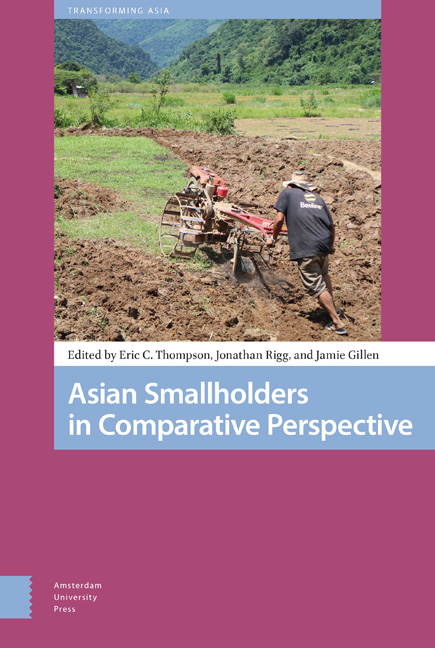Book contents
- Frontmatter
- Contents
- List of Maps, Figures and Tables
- Preface
- Introduction: Asian Smallholders in Comparative Perspective
- 1 Cambodia: Political Strife and Problematic Land Tenure
- 2 Indonesia: Whither Involution, Demographics, and Development?
- 3 Japan: Government Interventions and Part-time Family Farming
- 4 Laos: Responding to Pressures and Opportunities
- 5 Malaysia: The State of/in Village Agriculture
- 6 The Philippines: Fragmented Agriculture , Aquaculture, and Vulnerable Livelihoods
- 7 Singapore: Making Space for Farming
- 8 Taiwan: Toward the Revitalization of Smallholder Agriculture
- 9 Thailand: The Political Economy of Post-Peasant Agriculture
- 10 Vietnam: From Socialist Transformation to Reform
- Index
Introduction: Asian Smallholders in Comparative Perspective
Published online by Cambridge University Press: 21 November 2020
- Frontmatter
- Contents
- List of Maps, Figures and Tables
- Preface
- Introduction: Asian Smallholders in Comparative Perspective
- 1 Cambodia: Political Strife and Problematic Land Tenure
- 2 Indonesia: Whither Involution, Demographics, and Development?
- 3 Japan: Government Interventions and Part-time Family Farming
- 4 Laos: Responding to Pressures and Opportunities
- 5 Malaysia: The State of/in Village Agriculture
- 6 The Philippines: Fragmented Agriculture , Aquaculture, and Vulnerable Livelihoods
- 7 Singapore: Making Space for Farming
- 8 Taiwan: Toward the Revitalization of Smallholder Agriculture
- 9 Thailand: The Political Economy of Post-Peasant Agriculture
- 10 Vietnam: From Socialist Transformation to Reform
- Index
Summary
Asia's trope is one of modernization. Economic growth and structural change are transforming the region, with implications for the balance of global production and trade. In light of this, it is easy to forget that the most numerous economic and social unit across Asia is the “smallholder” or small-scale agriculturalist. Globally there are estimated to be 570 million such rural producers, and of these some three-quarters or 420 million are to be found in Asia (Hazell et al. 2010; Lowder et al. 2014, 2016; Fan and Kang-Chan 2005:135; Samberg et al. 2016).
The expectation from the early twentieth century onward, not least on the part of agricultural economists, was that small-scale agriculture would rapidly give way to land consolidation and large-scale farming, with a shift of populations into the urban and industrial sectors (Banaji 1990; Birner and Resnick 2010; Kautsky 1988). Engel's Law (Bezemer and Hazell 2006: 2) and the “natural” process of the farm-size transition (Hazell and Rahman, 2014: 3) predicted as much. More than a century on, while this has largely happened in places like Europe and North America – the historical experience of which underpinned such assumptions – smallholder and small-scale agriculture have apparently persisted in other places, and not least in Asia (Drahmoune 2013; Rigg et al. 2016). Village-based and family farming continue to be the image of farming in Asia, often shored up by an enduring stereotype of the Asian countryside as a haven of peace and a redoubt of tradition. Realities on the ground, of course, are far more complex. On the one hand, preindustrial, subsistence-oriented “peasant” agriculture is by and large a thing of the past (Elson 1997), and in any case was likely never as peaceful, moral or egalitarian as accounts often present (see Rigg 2019). At the same time, there are many places where small-scale and smallholder agriculture continues to predominate, apparently viable even when crowded out or marginalized by consolidated plantation-type agricultural ventures.
This book takes stock of the situation of small-scale and smallholder agriculture across East and Southeast Asia. It takes as its geographical “field”, ten countries: Cambodia, Indonesia, Japan, Laos, Malaysia, the Philippines, Singapore, Taiwan, Thailand, and Vietnam. These countries are, self-evidently, a varied group ranging from low to high-income, from putatively communist to democratizing, and from land-short to landabundant.
- Type
- Chapter
- Information
- Asian Smallholders in Comparative Perspective , pp. 13 - 38Publisher: Amsterdam University PressPrint publication year: 2019



